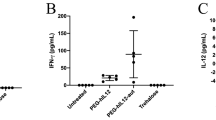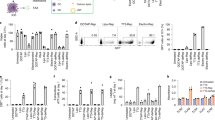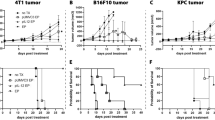Abstract
Our laboratory has recently developed a lipopolyplex consisting of DOTAP:cholesterol liposomes, protamine sulfate, and plasmid DNA (LPD) that provides improved systemic gene delivery compared with lipoplex following tail vein injection in mice. Because endothelial cells are the primary cells transfected in the lung, it was hypothesized that LPD might be an effective vector for gene therapy of pulmonary metastases. This hypothesis was examined by testing the efficacy of cytokine (IL-12) and tumor suppressor (p53) strategies for treatment of an experimental model of pulmonary metastasis in C57Bl/6 mice. Surprisingly, all LPD complexes including those containing an ‘empty’ plasmid provided a potent (>50% inhibition) and dose-dependent antitumor effect, compared with dextrose-treated controls. In addition, i.v. injections of LPD containing ‘empty’ plasmid also inhibited tumor growth in a subcutaneous model of C3 fibrosarcomma. The antitumor effect correlated well with a strong and rapid proinflammatory cytokine (TNF-α, IL-12 and IFN-γ) response. Naked plasmid DNA did not elicit a cytokine response and the response required assembly of DNA into a lipoplex or the LPD lipopolyplex. Except for the heart, elevated levels of cytokine were observed in all organs (lung, liver, kidney and spleen) where LPD is known to have gene transfer activity. Methylation of immune-stimulatory CpG motifs in the plasmid component of LPD inhibited the proinflammatory cytokine response as well as the antitumor effect of LPD in both tumor systems. This suggests that i.v. administration of LPD elicits a systemic proinflammatory cytokine response that mediates the antitumor activity of the lipopolyplex. In addition, the antitumor activity was not observed in SCID mice suggesting a possible role for B or T lymphocytes in the antitumor response initiated by LPD. This represents the first demonstration that an intravenously administered cationic liposome-based nonviral vector can promote a systemic, Th1-like innate immune response. The immune adjuvant properties of LPD might prove to be suitable for delivering tumor-specific antigens in the context of DNA vaccination.
This is a preview of subscription content, access via your institution
Access options
Subscribe to this journal
Receive 12 print issues and online access
$259.00 per year
only $21.58 per issue
Buy this article
- Purchase on Springer Link
- Instant access to full article PDF
Prices may be subject to local taxes which are calculated during checkout








Similar content being viewed by others
References
Gao X, Huang L . Potentiation of cationic liposome-mediated gene delivery by polycations Biochemistry 1996 35: 1027–1036
Sorgi FL, Bhattacharya S, Huang L . Protamine sulfate enhances lipid-mediated gene transfer Gene Therapy 1997 4: 961–968
Li S, Huang L . In vivo gene transfer via intravenous administration of cationic lipid-protamine-DNA (LPD) complexes Gene Therapy 1997 4: 891–900
Li S, Rizzo M, Bhattacharya S, Huang L . Characterization of cationic lipid-protamine-DNA (LPD) complexes for intravenous gene delivery Gene Therapy 1998 5: 930–937
Li S et al. Effect of immune response on gene transfer to the lung via systemic administration of cationic lipidic vectors Am J Physiol 1999 276: L796–L804
Song YK, Liu F, Chu S, Liu D . Characterization of cationic liposome-mediated gene transfer in vivo by intravenous administration Hum Gene Ther 1997 8: 1585–1594
Irvine KR et al. Enhancing efficacy of recombinant anticancer vaccines with prime/boost regimens that use two different vectors J Nat Cancer Inst 1997 89: 1595–1601
Nakaichi M, Takeuchi A, Shitara N, Takakura K . The antitumor activity of the DNA fraction from Mycobacterium bovis BCG (MY-1) for glioblastoma J Vet Med Sci 1995 57: 583–585
Krieg AM, Love-Homan L, Yi AK, Harty JT . CpG DNA induces sustained IL-12 expression in vivo and resistance to Listeria monocytogenes challenge J Immunol 1998 161: 2428–2434
Sparwasser T et al. Macrophages sense pathogens via DNA motifs: induction of tumor necrosis factor-alpha-mediated shock Eur J Immunol 1997 27: 1671–1679
Conry RM et al. Selected strategies to augment polynucleotide immunization Gene Therapy 1996 3: 67–74
Hurpin C et al. The mode of presentation and route of administration are critical for the induction of immune responses to p53 and antitumor immunity Vaccine 1998 16: 208–215
Parker SE et al. Plasmid DNA gene therapy: studies with the human interleukin-2 gene in tumor cells in vitro and in the murine B16 melanoma model in vivo Cancer Gene Ther 1996 3: 175–185.
Freimark BD et al. Cationic lipids enhance cytokine and cell influx levels in the lung following administration of plasmid: cationic lipid complexes J Immunol 1998 160: 4580–4586
Schwartz DA et al. CpG motifs in bacterial DNA cause inflammation in the lower respiratory tract J Clin Invest 1997 100: 68–73.
Krieg AM . Lymphocyte activation by CpG dinucleotide motifs in prokaryotic DNA Trends Microbiol 1996 4: 73–76
Stacey KJ, Sweet MJ, Hume DA . Macrophages ingest and are activated by bacterial DNA J Immunol 1996 157: 2116–2122
Jakob T et al. Activation of cutaneous dendritic cells by CpG-containing oligodeoxynucleotides: a role for dendritic cells in the augmentation of Th1 responses by immunostimulatory DNA J Immunol 1998 161: 3042–3049
Sparwasser T et al. Bacterial DNA and immunostimulatory CpG oligonucleotides trigger maturation and activation of murine dendritic cells Eur J Immunol 1998 28: 2045–2054
Klinman DM et al. CpG motifs present in bacteria DNA rapidly induce lymphocytes to secrete interleukin 6, interleukin 12, and interferon gamma Proc Nat Acad Sci USA 1996 93: 2879–2883
Yi AK, Chace JH, Cowdery JS, Krieg AM . IFN-gamma promotes IL-6 and IgM secretion in response to CpG motifs in bacterial DNA and oligodeoxynucleotides J Immunol 1996 156: 558–564
Ballas ZK, Rasmussen WL, Krieg AM . Induction of NK activity in murine and human cells by CpG motifs in oligodeoxynucleotides and bacterial DNA J Immunol 1996 157: 1840–1845
Chace JH et al. Bacterial DNA-induced NK cell IFN-gamma production is dependent on macrophage secretion of IL-12 Clin Immunol Immunopathol 1997 84: 185–193
He Y, Huang L . Growth inhibition of human papillomavirus 16 DNA-positive mouse tumor by antisense RNA transcribed from U6 promoter Cancer Res 1997 57: 3993–3999
Hofland H, Huang L . Inhibition of human ovarian carcinoma cell proliferation by liposome–plasmid DNA complex Biochem Biophys Res Commun 1995 207: 492–496
Sweet MJ et al. IFN-gamma primes macrophage responses to bacterial DNA J Inter Cytok Res 1998 18: 263–271
Lew D et al. Cancer gene therapy using plasmid DNA: pharmacokinetic study of DNA following injection in mice (see comments) Hum Gene Ther 1995 6: 553–564
Cowdery JS, Chace JH, Yi AK, Krieg AM . Bacterial DNA induces NK cells to produce IFN-gamma in vivo and increases the toxicity of lipopolysaccharides J Immunol 1996 156: 4570–4575.
Yu A et al. RB-mediated suppression of spontaneous multiple neuroendocrine neoplasia and lung metastases in Rb+/− mice Proc Nat Acad Sci USA 1999 96: 3916–3921
Lui Y et al. Systemic gene delivery expands the repertoire of effective antiangiogenic agents J Biol Chem 1999 274: 13338–13344.
Gorelik E, Peppoloni S, Overton R, Herberman RB . Increase in H-2 antigen expression and immunogenicity of BL6 melanoma cells treated with N-methyl-N′-nitronitrosoguanidine Cancer Res 1985 45: 5341–5347
Gorelik E, Gunji Y, Herberman RB . H-2 antigen expression and sensitivity of BL6 melanoma cells to natural killer cell cytotoxicity J Immunol 1988 140: 2096–2102
De Bruijn ML et al. Immunization with human papillomavirus type 16 (HPV16) oncoprotein-loaded dendritic cells as well as protein in adjuvant induces MHC class I-restricted protection to HPV16-induced tumor cells Cancer Res 1998 58: 724–731
Ressing ME et al. Human CTL epitopes encoded by human papillomavirus type 16 E6 and E7 identified through in vivo and in vitro immunogenicity studies of HLA-A*0201-binding peptides J Immunol 1995 154: 5934–5943
Feltkamp MC et al. Cytotoxic T lymphocytes raised against a subdominant epitope offered as a synthetic peptide eradicate human papillomavirus type 16-induced tumors Eur J Immunol 1995 25: 2638–2642
Hwu P et al. In vivo antitumor activity of T cells redirected with chimeric antibody/T-cell receptor genes Cancer Res 1995 55: 3369–3373.
Tuting T, Storkus W, Lotze M . Gene-based strategies for the immunotherapy of cancer J Mol Med 1997 75: 478–491
Maini A et al. New developments in the use of cytokines for cancer therapy Anticancer Res 1997 17: 3803–3808
Brazolot Millan CL et al. CpG DNA can induce strong Th1 humoral and cell-mediated immune responses against hepatitis B surface antigen in young mice Proc Nat Acad Sci USA 1998 95: 15553–15558
He YK et al. Potentiation of E7 antisense RNA-induced antitumor immunity by co-delivery of IL-12 gene in HPV16 DNA-positive mouse tumor Gene Therapy 1998 5: 1462–1471
Robbins PD, Tahara H, Ghivizzani SC . Viral vectors for gene therapy Trends Biotechnol 1998 16: 35–40
Liu Y et al. Cationic liposome-mediated intravenous gene delivery J Biol Chem 1995 270: 24864–24870
Stiles BG, Bavari S, Krakauer T, Ulrich RG . Toxicity of staphylococcal enterotoxins potentiated by lipopolysaccharide: major histocompatibility complex class II molecule dependency and cytokine release Infect Immun 1993 61: 5333–5338
Hinshaw LB et al. Lethal Staphylococcus aureus-induced shock in primates: prevention of death with anti-TNF antibody J Trauma 1992 33: 568–573
Freudenberg MA, Galanos C . Tumor necrosis factor alpha mediates lethal activity of killed gram-negative and gram-positive bacteria in D-galactosamine-treated mice Infect Immun 1991 59: 2110–2115
Templeton NS et al. Improved DNA: liposome complexes for increased systemic delivery and gene expression Nat Biotechnol 1997 15: 647–652
Shiloni E et al. Retroviral transduction of interferon-gamma cDNA into a nonimmunogenic murine fibrosarcoma: generation of T cells in draining lymph nodes capable of treating established parental metastatic tumor Cancer Immunol Immunother 1993 37: 286–292
Karp SE et al. Cytokine secretion by genetically modified nonimmunogenic murine fibrosarcoma. Tumor inhibition by IL-2 but not tumor necrosis factor J Immunol 1993 150: 896–908
Wexler H . Accurate identification of experimental pulmonary metastases J Nat Cancer Inst 1966 36: 641–645
Acknowledgements
This work was supported by grants from NIH (CA 24553, CA 64654 and CA 71731) and a grant from Targeted Genetics (Seattle, WA, USA). We wish to thank Dr Patrick Hwu for supplying experimental pulmonary metastasis cell line 24JK-FBP, Dr Paul Robbins for supplying pCMV-p53 and the empty vector pCMV-Neo, and Dr Micheal Lotze for suppyling pIL-12.
Author information
Authors and Affiliations
Rights and permissions
About this article
Cite this article
Whitmore, M., Li, S. & Huang, L. LPD lipopolyplex initiates a potent cytokine response and inhibits tumor growth. Gene Ther 6, 1867–1875 (1999). https://doi.org/10.1038/sj.gt.3301026
Received:
Accepted:
Published:
Issue Date:
DOI: https://doi.org/10.1038/sj.gt.3301026
Keywords
This article is cited by
-
Prevention of liver tumor formation in woodchucks with established hepatocellular carcinoma by treatment with cationic liposome-DNA complexes
BMC Cancer (2017)
-
Genetic Immunization With In Vivo Dendritic Cell-targeting Liposomal DNA Vaccine Carrier Induces Long-lasting Antitumor Immune Response
Molecular Therapy (2016)
-
Role of liposome and peptide in the synergistic enhancement of transfection with a lipopolyplex vector
Scientific Reports (2015)
-
Systemic TNFα Gene Therapy Synergizes With Liposomal Doxorubicine in the Treatment of Metastatic Cancer
Molecular Therapy (2013)
-
Efficient Biodistribution and Gene Silencing in the Lung epithelium via Intravenous Liposomal Delivery of siRNA
Molecular Therapy - Nucleic Acids (2013)



